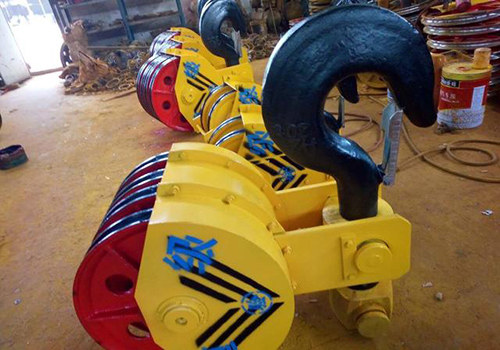Lifting product introduction: hook group
2021.08.16Product principle: The hook is a kind of sling suspended on the wire rope of the hoisting mechanism by means of pulley blocks and other components. It is often used as a connection between the lifting mechanism of the crane and the items to be transported. It is widely used in industries such as factories, mines, petroleum, chemical industry and ship terminals.
Common classification: There are many types of hooks, which can be divided into two categories: single hook and double hook according to their shape. The lifting weight ranges from 5 tons to 150 tons. Specifically, single hooks are used for adjustments below 80 tons, and double hooks with symmetrical forces are used when the lifting weight is larger.
Structural composition: The hook group is generally composed of hooks, hook beams, thrust bearings, hook nuts, pulleys, pulley shafts, pull plates and pulley covers.
Processing technology: In strict accordance with national standards, generally the toughness of No. 20 carbon steel is used as raw material, and it is made by hot forging, welding, heat treatment, quenching and tempering, etc., with beautiful appearance and reliable quality.
Product advantages:
1. Durable: good materials, good quality, 13 years of industry experience, mature and reliable technology.
2. Simple operation: simple installation, easy operation and maintenance,
3. Flexible and safe: The hook can rotate flexibly within the range of 360 in the horizontal direction and 180 in the vertical direction. The product has high tensile strength, small yield ratio, and safe and reliable quality.
4. Support customization: high production accuracy, solving customer demand problems

1. Acceptance:
(1) The surface of the hook should be smooth and free of defects such as peeling, sharp corners, burrs, and seams
(2) The hook group needs to rotate flexibly, and the positioning bolts and cotter pins of the fixed nut must be tightened completely.
(3) Verify the technical certification documents of the manufacturer, and measure and inspect the opening degree of the hook.
2. Matters needing attention:
1. The new hook should be subjected to a load test.
2. Regularly check the hook connection part to confirm whether the connection is reliable and the lubrication is good.
3. The hook shall not be overloaded.
4. The hook should be replaced as soon as possible if there is a crack on the surface, the thread is corroded, the dangerous section or the neck is deformed.
5. The abrasion of the dangerous section area of the hook reaches 10%, and the opening degree is increased by 15% compared with the original size; if the torsion deformation of the hook body exceeds 10°, it shall be scrapped.
< 上一篇
没有了!
下一篇 >
没有了!
